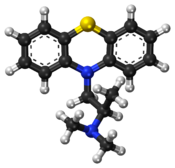Promethazine
 |
|
 |
|
| Clinical data | |
|---|---|
| Trade names | Phenergan, Histantil |
| AHFS/Drugs.com | Monograph |
| MedlinePlus | a682284 |
| Pregnancy category |
|
| Routes of administration |
Oral, rectal, IV, IM, topical |
| ATC code | D04AA10 (WHO) R06AD02 (WHO) |
| Legal status | |
| Legal status |
|
| Pharmacokinetic data | |
| Bioavailability | 88% absorbed but after first-pass metabolism reduced to 25% absolute bioavailability |
| Protein binding | 93% |
| Metabolism | Hepatic glucuronidation and sulfoxidation |
| Biological half-life | 16-19 hours |
| Excretion | Renal and biliary |
| Identifiers | |
|
|
| CAS Number |
60-87-7 58-33-3 (hydrochloride) |
| PubChem (CID) | 4927 |
| IUPHAR/BPS | 7282 |
| DrugBank |
DB01069 |
| ChemSpider |
4758 |
| UNII |
FF28EJQ494 |
| KEGG |
D00494 |
| ChEBI |
CHEBI:8461 |
| ChEMBL |
CHEMBL643 |
| ECHA InfoCard | 100.000.445 |
| Chemical and physical data | |
| Formula | C17H20N2S |
| Molar mass | 284.42 g/mol |
| 3D model (Jmol) | Interactive image |
| Chirality | Racemic mixture |
|
|
|
|
Promethazine is a neuroleptic medication and first-generation antihistamine of the phenothiazine family. The drug has strong sedative and weak antipsychotic effects. It also reduces motion sickness and has antiemetic and anticholinergic properties (via its action on the dopamine receptor D2). In some countries it is prescribed for insomnia when benzodiazepines are contraindicated. It is available in many countries under many brand names. Promethazine was developed in the mid 1940s when a team of scientists from Rhône-Poulenc laboratories were able to synthesize it from phenothiazine and a diamine side chain of diphenhydramine.
Some documented side effects include:
Extremely rare side effects include:
Because of potential for more severe side effects, this drug is on the list to avoid in the elderly. (See NCQA’s HEDIS Measure: Use of High Risk Medications in the Elderly). In many countries (including the US and UK), promethazine is contraindicated in children less than two years of age, and strongly cautioned against in children between two and six, due to problems with respiratory depression and sleep apnea.
Promethazine is listed as one of the drugs of highest anticholinergic activity in a study of anticholinergenic burden, including long-term cognitive impairment.
...
Wikipedia
